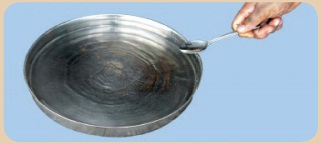Sound | Chapter 6 | 8th Science - Production of Sound | 8th Science : Chapter 6 : Sound
Chapter: 8th Science : Chapter 6 : Sound
Production of Sound
Production of Sound
Sound is produced when an object is
set to vibrate. Vibration means a kind of rapid to and fro motion of a
particle. This to and fro motion of the particle causes the substances around
it to vibrate. Thus sound spreads to the surroundings. The substance through
which sound is transmitted is called medium. Sound moves through a medium from
the point of generation to the listener. We can understand the production of
sound with the help of some activities.
Activity 1
Take the tray of an
empty match box and stretch a rubber band around it, along its length. Then,
pluck the stretched rubber band with your index finger. What do you observe? Do
you hear any sound?

Answer:
Observation
:
(i) On plucking the rubber band, it starts vibrating.
(ii) We can hear a feeble humming sound as long as the rubber
band is vibrating.
(iii) The humming sound stops as soon as the rubber band stops
vibrating.
Conclusion
: This confirms that sound is produced by vibrating bodies.
On plucking the rubber band, it
starts vibrating. You can hear a feeble humming sound as long as the rubber
band is vibrating. The humming sound stops as soon as the rubber band stops
vibrating. This confirms that sound is produced by vibrating particles. You can
see this kind of vibrations in stringed musical instruments, such as guitar and
sitar also.
Activity 2
Take a metal shallow
pan. Hang it at a convenient place in such a way that it does not touch
anything. Now, strike it with a stick. Touch the pan gently with your index
finger. Do you feel the vibrations? Again, strike the pan with the stick and
hold it tightly with your hands, immediately after striking. Do you still hear
the sound?

Answer:
Case 1 :
(i) Now, strike it with a stick.
(ii) Touch the pan gently with your index finger. Do you feel
the vibrations?
Observation
:
we can the feel the vibration for sometime.
Case 2 :
(i) Strike the pan with the stick and hold tightly with your
hands, immediately after striking.
(ii) Do you still hear the sound?
Observation
:
we cannot hear the sound.
Conclusion
: This activity shows the vibrating pan produces sound.
This activity shows that vibrating
pan produces sound. In this case vibrations can be felt by touching the pan.
But in some cases vibrations are visible.
Activity 3
Take a metal dish,
pour some water in it. Strike it at its edge with a spoon. Do you hear any
sound? Again strike the dish and touch it. Can you feel the dish vibrating?
Look at the surface of water. Do you see any movement on the water surface?
Now, hold the dish with your hands. What change do you observe on the surface
of the water?

Answer: We see that a vibrating object produces sound.
Again
strike the dish and touch it. Can you feel the dish vibrating?
Answer: I can feel the dish vibrating.
Strike
the dish again. Look at the surface of water. Do you see any movement on the water surface?
Answer: I can see the waves on the surface of water.
Now, hold
the dish. What change do you observe on the surface of water?
Answer: I cannot see the waves on the surface of water.
The above activities show that sound
is produced when an object is set to vibrate. The sound produced by vibration
is propagated from one location to another. When it reaches our ear we hear the
sound.
Related Topics